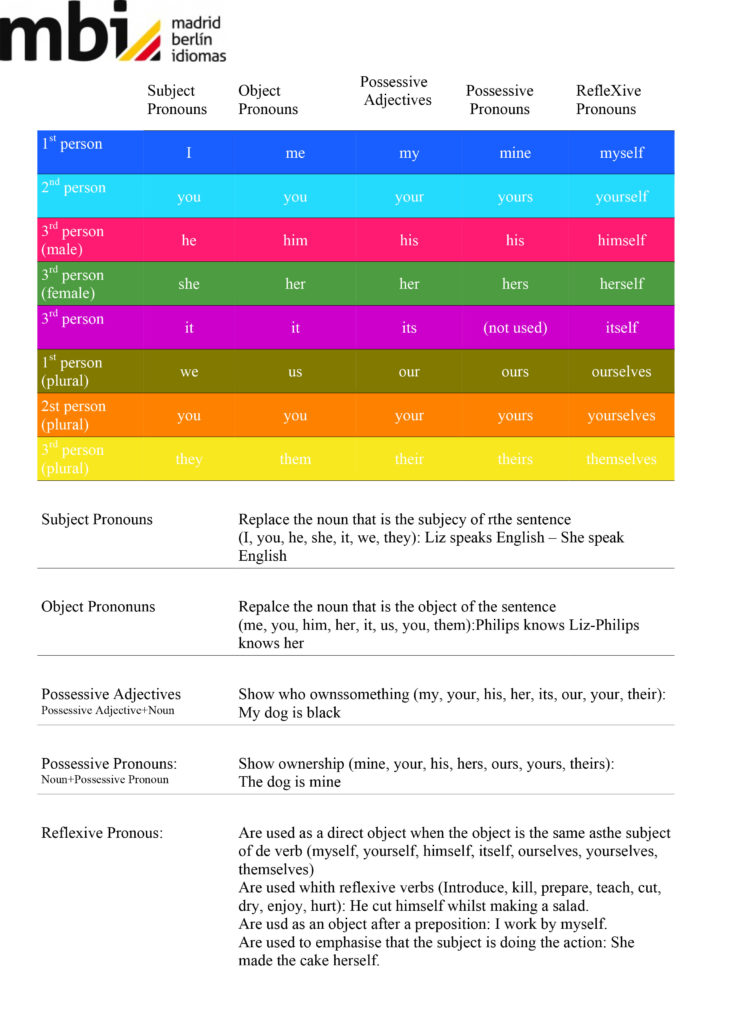137.-Possesive Determiners

Possesive Determiners
What is a possessive determiner?
Possessive determiners, also known as possessive adjectives, are a class of determiners that are used to modify nouns to denote possession. They take the place of the definite article the, and state whom or what an item belongs to. We use a different possessive determiner to correspond with each personal pronoun. The main possessive determiners in English are:
| Personal Pronoun | Possessive Determiner |
| I | my |
| you | your |
| he | his |
| she | her |
| it | its |
| we | our |
| they | their |
The word whose and the structure noun + possessive apostrophe also function as possessive determiners, as we will see.
Using Possessive Determiners
Sentence placement
Possessive determiners are usually placed in front of the noun they modify. For example:
- “You remember Hannah, right? This is her brother, Richard.”
- “Please return my books as soon as possible.”
- “Have they found their tickets yet?”
- “The Earth spins on its* axis.”
If the noun is further modified by one or more other determiners, the possessive determiner is placed first. For example:
- “You remember Hannah, right? This is her little brother, Richard.”
- “Please return my three library books as soon as possible.”
- “Have they found their train tickets yet?”
- “The Earth spins on its invisible axis.”
(*Usage Note: A common mistake is to use an apostrophe with the word it when we want to indicate possession. It’s is a contraction that we use instead of writing out it is or it has. If we want to denote possession, we must use its without an apostrophe.)
Whose*
Whose is used as a possessive determiner in interrogative sentences to inquire about possession, as well as in indirect questions when the identity of the owner is unknown. For example:
- “Whose coat is this?”
- “Do you know whose idea this was?”
- “I need to find out whose car this is. They keep parking in my spot.”
(*Usage Note: Similar to the issue with its, a common mistake is to use who’s rather than whose when we want to inquire about possession. Who’s is a contraction of who is; if we want to denote possession, we must use the possessive determiner whose.
The possessive apostrophe
We can form possessive determiners from other pronouns, nouns, and noun phrases by adding the possessive apostrophe + “s” (or just the apostrophe for plural nouns). For example:
- “Caring for one’s family is very important.”
- “Hannah’s car is parked outside; she must have already arrived.”
- “The former Attorney General’s recommendations were included in the report.”
- “Our school takes parents’ concerns very seriously.”
Differences with possessive pronouns
Possessive determiners are often confused with possessive personal pronouns (mine, yours, his, hers, its, ours, theirs). Although some of the forms overlap, there are important distinctions between the two types of possessives.
While possessive pronouns can stand on their own, taking the place of a noun, possessive determiners cannot. For example:
- Speaker A: “Whose is this book?”
- Speaker B: “It’s mine.” (correct)
- Speaker B: “It’s my.” (incorrect)
The second example is incorrect because possessive determiners, such as my, can modify a noun, but cannot replace one. We would need to include the noun book in order to use the possessive determiner, as in:
- Speaker A: “Whose is this book?”
- Speaker B: “It’s my book.” (correct)
Note, however, that possessive determiners formed using “-’s” can function both as determiners and pronouns, as in:
- Speaker A: “Whose is this book?”
- Speaker B: “It’s Jane’s book.” (correct)
or
- Speaker B: “It’s Jane’s.” (correct)
Another distinction is that although the structure of + possessive pronoun can be used to create a possessive sentence, a possessive determiner gives the noun a more definite meaning. Compare the following two sentences:
- “A friend of mine is going to come with us.”
- “My friend is going to come with us.”
The first example gives the impression that either the speaker is unsure which friend is going to come, or that the listener has never met the friend. On the other hand, the second example, which uses the possessive determiner my to directly modify the noun friend, gives the impression that the speaker has a definite friend in mind, and/or the listener is familiar with this friend.



